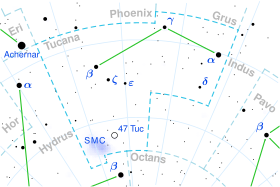
Back Alpha Tucanae AF Alfa Tucanae AST Alfa del Tucà Catalan Alfa Tucanae Czech Alpha Tucanae German Alfa Tucanae Spanish آلفا توکان FA Alpha Tucanae French Alfa Tucanae GL אלפא בטוקאן HE
| Observation data Epoch J2000 Equinox J2000 | |
|---|---|
| Constellation | Tucana |
| Right ascension | 22h 18m 30.11244s[1] |
| Declination | −60° 15′ 34.6664″[1] |
| Apparent magnitude (V) | 2.86[2] |
| Characteristics | |
| Spectral type | K3 III[3] |
| U−B color index | +1.54[2] |
| B−V color index | +1.39[2] |
| Astrometry | |
| Radial velocity (Rv) | +45.8[4] km/s |
| Proper motion (μ) | RA: −77.000[1] mas/yr Dec.: −32.823[1] mas/yr |
| Parallax (π) | 17.7324 ± 0.3290 mas[1] |
| Distance | 184 ± 3 ly (56 ± 1 pc) |
| Absolute magnitude (MV) | −1.05[5] |
| Absolute bolometric magnitude (Mbol) | −1.97[5] |
| Orbit[6] | |
| Period (P) | 4197.7 days |
| Eccentricity (e) | 0.39 |
| Periastron epoch (T) | 18666.4 |
| Argument of periastron (ω) (secondary) | 48.5° |
| Semi-amplitude (K1) (primary) | 7.2 km/s |
| Details | |
| Mass | 2.5 - 3[7] M☉ |
| Radius | 37[7] R☉ |
| Luminosity | 424[7] L☉ |
| Temperature | 4300[7] K |
| Other designations | |
| Database references | |
| SIMBAD | data |
Alpha Tucanae (α Tuc, α Tucanae) is a binary star system in the southern circumpolar constellation of Tucana. With an apparent visual magnitude of 2.86,[2] it can be seen with the naked eye from the southern hemisphere. Using parallax measurements, the distance to this system can be estimated as 184 light-years (56 parsecs). A cool star with a surface temperature of 4300 K, it is 424 times as luminous as the sun and 37 times its diameter. It is 2.5 to 3 times as massive. It is unclear what stage of evolution the star is in.[7]
This is a spectroscopic binary, which means that the two stars have not been individually resolved using a telescope, but the presence of the companion has been inferred from measuring changes in the spectrum of the primary. The orbital period of the binary system is 4197.7 days (11.5 years).[6] The primary component has a stellar classification of K3 III,[3] which indicates it is a giant star that has exhausted the supply of hydrogen at its core and evolved away from the main sequence. It has the characteristic orange hue of a K-type star.
- ^ a b c d e Vallenari, A.; et al. (Gaia collaboration) (2023). "Gaia Data Release 3. Summary of the content and survey properties". Astronomy and Astrophysics. 674: A1. arXiv:2208.00211. Bibcode:2023A&A...674A...1G. doi:10.1051/0004-6361/202243940. S2CID 244398875. Gaia DR3 record for this source at VizieR.
- ^ a b c d Cite error: The named reference
clpl4was invoked but never defined (see the help page). - ^ a b Cite error: The named reference
houk1978was invoked but never defined (see the help page). - ^ Cite error: The named reference
mnras139_341was invoked but never defined (see the help page). - ^ a b Pasquini, L.; de Medeiros, J. R.; Girardi, L. (2000). "Ca II activity and rotation in F-K evolved stars". Astronomy and Astrophysics. 361: 1011–1022. arXiv:astro-ph/0008109. Bibcode:2000A&A...361.1011P.
- ^ a b Cite error: The named reference
ncsbowas invoked but never defined (see the help page). - ^ a b c d e Kaler, Jim. "Alpha Tucanae". Stars. University of Illinois. Retrieved 19 October 2013.
- ^ Cite error: The named reference
SIMBADwas invoked but never defined (see the help page).
